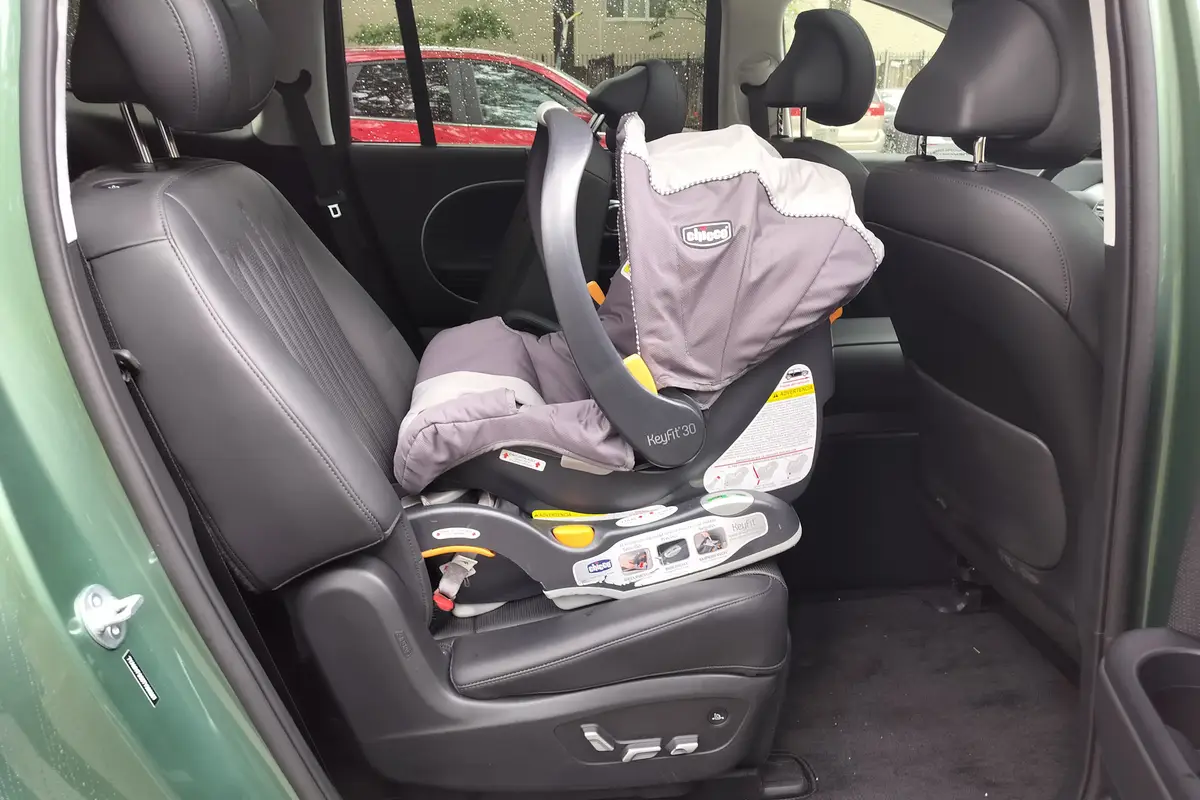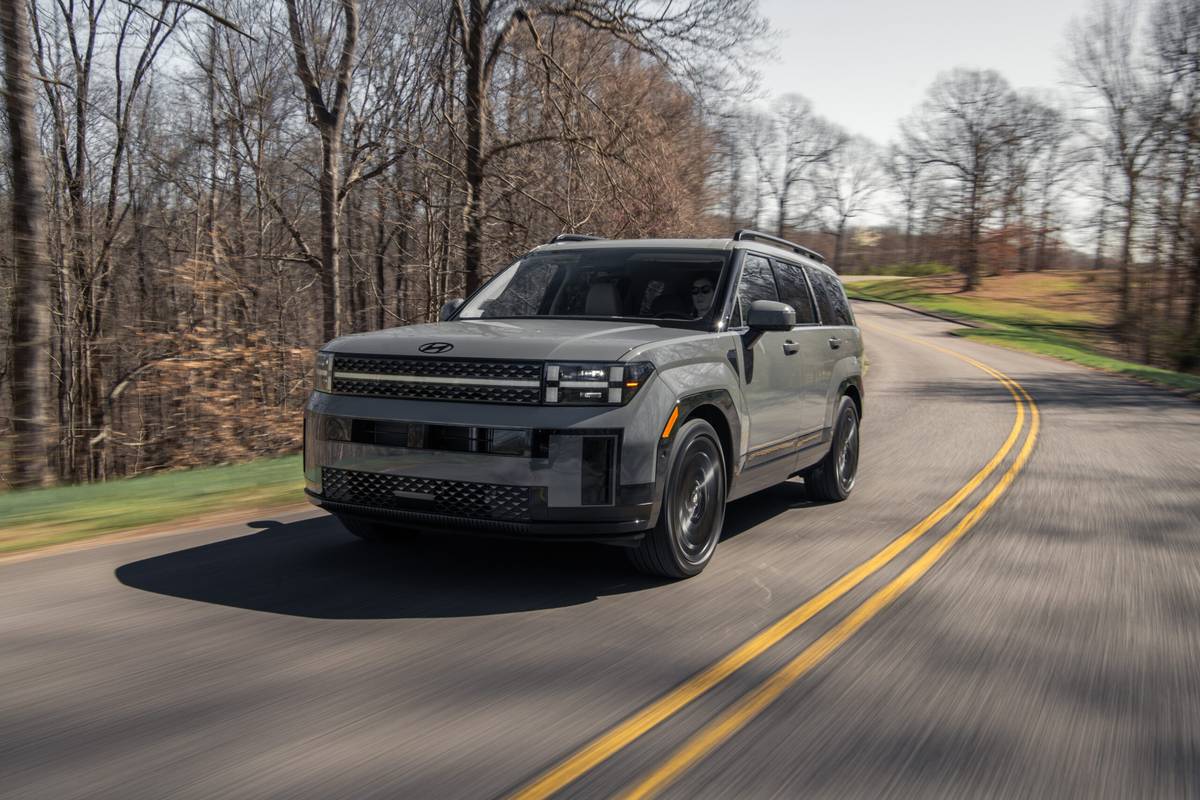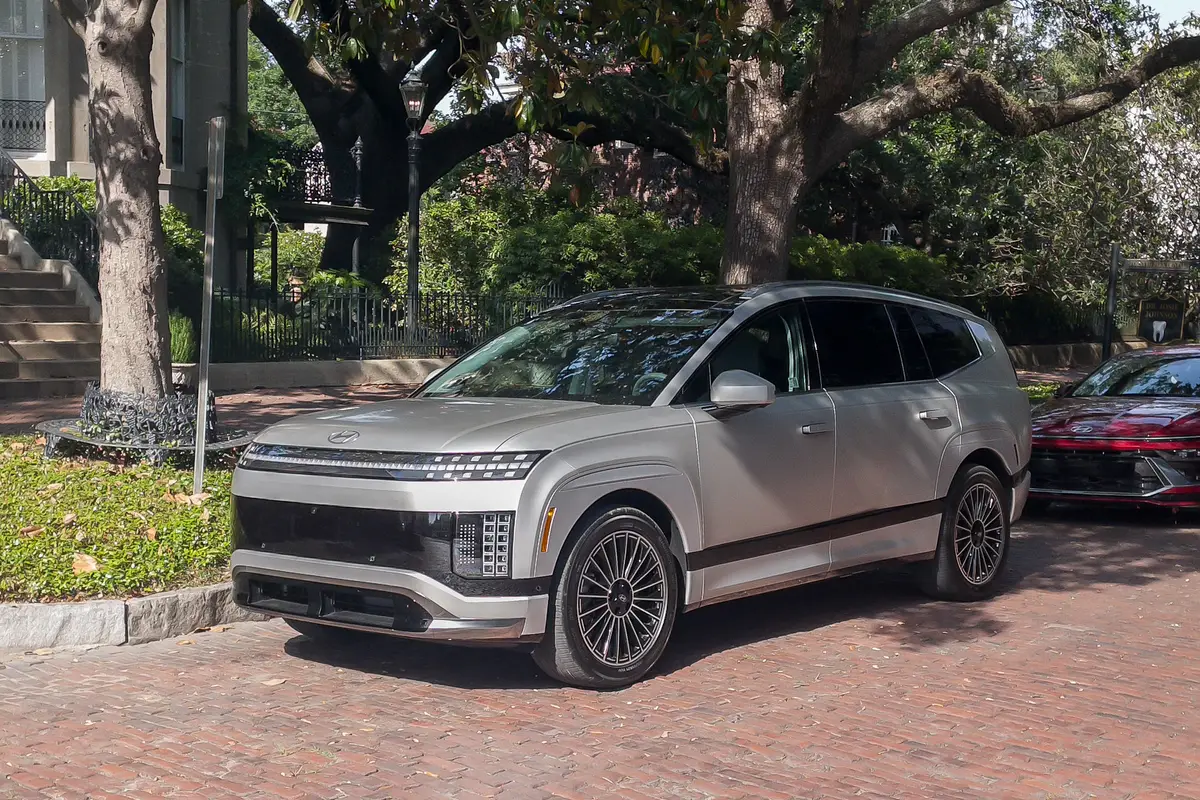Video: 2024 Hyundai Kona Review: Bigger, Bolder, Better
By Cars.com Editors
September 12, 2023
Share
About the video
Cars.com Editor Damon Bell headed to Baltimore to drive the top-line and sport-themed versions of the redesigned 2024 Hyundai Kona. The Kona’s basic powertrains carry over to the new-generation model, but the rest is all-new — and improved.
Transcript
We're here in Baltimore, Maryland for our first drives of the redesigned 2024 Hyundai Kona SUV. This is Hyundai's subcompact SUV but it's not quite as small as it used to be.
It grows almost six inches in overall length and two inches in wheel base with the redesign. It also gets some striking futuristic styling touches as well as some welcome new tech features. Let's check it out. Now, despite the Kona's upsize dimensions, the basic bobtail proportions carry over from the previous generation model but we've got a number of futuristic styling touches that give it a slightly more aggressive look. Chief among those is this slim LED daytime running light bar in the front. This kind of puts me in the mind of a Cylon from the original "Battlestar Galactica" in a good way. Also a high tech touch, active grill shutters here on the gasoline engine Konas that power up when additional engine cooling is needed and close again for better aerodynamic performance. And yes, this is just a daytime running light. The actual headlights themselves are nestled in this pod further down on the fender. And moving along the side, we've got 19 inch wheels. This is the top line limited model which comes standard with nineteens as does the sporty N Line trim level. The limited also has this dark finish satin finish wheel cladding that gives the Kona a bit more of a rugged SUV look. The satin finished cladding also comes on the lesser gas engine Kona models, but the sporty N Line in the pure electric Kona Electric model switch this to body color trim. Moving further down the side, we've got this sharp body side crease with a smooth curved beneath it. That's something we've seen on a number of Hyundais recently, including the current generation Elantra that actually swoops up and picks up the curve of the trim on the C pillar. And again, once we get out back, we can see that bobtailed look of the previous generation Kona carried over with this new model. Moving to the back again, we've got the slim, vaguely sinister looking full width supplemental taillight treatment. The actual taillights and turn signals are in these lower pods here. Another slick detail is the center high mounted stop lamps smoothly integrated into the spoiler. And we've got an available power lift gate and hands-free power lift gate to access the newly enlarged cargo area. The new Kona has noticeably more cargo space in back than its predecessor did. It's now on par with some of the bigger members of the subcompact SUV class like the Kia Selto sorta Hyundai HR-V. According to Hyundai's measurements, there's 25.5 cubic feet of cargo space behind the rear seats and that grows to 63.7 cubic feet with the rear seat backs folded. The Kona's gasoline engines carry over from the previous generation model. The base engine is a 2.0 liter four cylinder that puts out 147 horsepower. But the top Line limited and the sporty N Line models get a turbocharged 1.6 liter four that puts out 190 horsepower. And this engine is now paired with a conventional eight speed automatic instead of the previous seven speed dual clutch automatic. The Kona's interior is nicely upgraded with the redesign. A key focal point feature is the dual 12.3 inch screens, that's a 12.3 inch digital gauge cluster, and a 12.3 inch infotainment touchscreen integrated into one slick seamless panel. The other nice thing about the Kona's interior is that Hyundai retained traditional physical buttons. We find these a lot easier to use when driving than touch sensitive or touchscreen controls. And there's also a nice little storage shelf complete with ambient lighting, even though you can't see it now, built into the passenger side of the dash. A lot of nice touches in the center console as well. There's a USB port that can be toggled between data and charging connection and merely a charging connection at the touch of a button. A wireless charging pad on certain models. The top Line limited model has ventilated seats. That's one of my favorite features. The center console is very slick as well. It's got retractable cup holder rings, so you can have the console open if you want more open storage space and then just press a button, the cup holders retract and you've got center cup holders. Interestingly, there's no forward partition or completely enclosed partition to the center armrest bin but you've got a separate storage tray and a decent amount of space here as well. Now the Hyundai Kona's rear seat space is much better than before, especially when you consider that I am 6'6. We have this front passenger seat set to be comfortable for a six foot front passenger and the fact that I can sneak my knees behind it at all is kind of a feat. I wouldn't wanna be back here for a long trip but for a crosstown jaunt I would be just fine. And again, average size adults are gonna be perfectly comfortable in these rear seats and they wouldn't have been as comfortable in a previous generation Kona. We've also got a nice center console at the back of the center console, dual USB charging ports and some air vents. The sporty Kona N Line model is mechanically the same as the limited but it gets some more aggressive looking styling touches like a racer looking front and rear fascia, a pronounced spoiler on the lift gate, inline badges, and race here looking 19 inch wheels. Inside the Kona N Line gets the appropriate level of sporty styling touches, including red contrast stitching on the steering wheel and seats, a nice red racing stripe across the midline of the dash, and the seats themselves have grippy suede upholstery inserts, an inline badge in the front seats, red racing stripes as well. Upper trim levels of the gasoline engine Konas as well as the Kona Electric get an unconventional shift control that sprouts out of the steering column. You just twist this knob forward for drive, back for reverse, and press the button on the end to engage park. It takes a little getting used to but we acclimated to it pretty quickly. Alright, we are behind the wheel of the Kona limited model. This is the top Line trim level, and like the N-Line, it's powered by a turbocharged 1.6 liter four cylinder that makes 190 horsepower. And unlike the previous generation Kona, it's paired with an eight speed traditional automatic transmission instead of the seven speed dual clutch automatic that it had previously. The engine itself is carried over. The transmission is new and I do like the more relaxed feel of the traditional eight speed when you're driving a dual clutch automatic. There can be some herky jerkiness every once in a while and this eight speed is a little more relaxed, a little more conventional feeling in everyday driving. And yeah, the power is quite good. Like you've got some passing power when you get on the throttle when you want it. So minimal turbo lag. Overall, a good everyday engine with more than enough pep for everyday commuting. Right now we are driving on a fairly smooth highway surface and the ride quality is pleasant. This limited and the N Line model have 19 inch wheels with shorter sidewalls than lesser Kona models which have seventeens or eighteens. So they might be a shade bumpier over rough roads than the others 'cause of the bigger diameter wheels. But in general, this is a pleasant ride. We'll see what it's like when we get to some bumpier roads. Right now we're on fairly smooth pavements. Overall, road noise is pretty good. Again, we're on fairly smooth quiet pavements. I'm hearing a little bit of tire roar, but nothing objectionable especially for the subcompact SUV class. This seems pretty quiet overall. I'm gonna step on the gas here and even under a serious throttle, the engine note is fairly muted. Here, in a tiny bit of wind rush but overall this is very respectably quiet for its class. My all around visibility is very nice, sitting up a little bit higher than I would be in a normal passenger car. So you've got a slightly elevated view of the road, a clean unobstructed view out the windshield, and the rear window is big enough that I can see very clearly through the rear view mirror. And the rear seat headrest only intrude a little bit. So yeah, rear view mirror's good as well. So all around visibility, this is very nice. I'm also digging this steering wheel. This is kind of a sporty feel. It's got the nubby protrusions right at the 10 and two positions where your hands are. Nice leather wrapped contrast stitching on the inside. This almost feels like it should be exclusive to the sportier looking N Line model, but the limited hazard as well. Yeah, it's a minor thing but this steering wheel gives it kind of a more athletic feel in and of itself. So I am six foot six, so I'm a good stress test for passenger space in most any vehicle. And usually my first step getting into any vehicle to drive it is to put the driver's seat all the way down and all the way back, which I did in this as well. And I was a little pleasantly surprised to find that I actually had to put the driver's seat forward an inch or two to have my optimal hand position on the steering wheel. So I think even an NBA player could drive this vehicle comfortably. I've got good headroom as well, enough space so my head isn't rushing even under the sunroof housing and that usually steals an inch or so of space from the headliner as well. So from the front seats, very tall person friendly. I think from the backseats, it's a little bit different story. Kind of clever storage spot for a cell phone. But as you can see, I took an exit ramp at a good speed and my phone did not stay a 100% put. But it's a nice ledge here with kind of a rubberized rib to put your cell phone there because the regular cup holder area, the center console bin, there's really not a partition for the cell phone there. And yeah, from behind the wheel, I am doubly appreciating Hyundai's choice to stick with physical buttons for most of the Kona's controls. Got handy little toggle levers for fan speed and temperature setting on the climate control system, also mode change for the climate control system. And speaking of climate, it is getting very hot here today. And the Kona, at least, in the top limited trim level comes with one of my favorite features and that is ventilated front seats. I've got them on high right now. And another nice thing about them is some ventilated seats when you've got them on the full setting, the fan is a little noisy but I'm not hearing the fan on these at all and they are keeping my backside cool for sure. These dual 12.3 inch display screens integrated into a single panel. Very nice. The graphics are clear and easy to read and we're in some kind of dappled morning sunlight and they are not washing out in the light that we're driving in now. Now the gasoline engine Kona's are starting to arrive in Hyundai dealerships now, with the all electric Kona Electric models slated to follow by the end of the year. Now, given the upsized dimensions and the new tech features, it's not too surprising that the new Kona costs more than its predecessor. Base prices go up around 1500 to $2,800 depending on trim level. The basic SE model starts at around 24.5 while the top line limited trim starts out at just under $33,000. To read my full review of the redesigned 2024 Hyundai Kona, head on over to cars.com. (upbeat music)
Featured stories

By Jennifer Geiger
July 9, 2025

By Patrick Masterson
July 2, 2025

By Drew Koenig
June 27, 2025
